Construction Simulation and Monitoring of the Jacking Steel Truss and Main Column of a Super High-Rise Building
Abstract
:1. Introduction
- (1)
- Under normal circumstances, the core tube building with a height of more than 350 m is suitable for the overall jacking formwork structure for construction operations. The integral lifting formwork structure is a relatively safe and closed operation system. Its formwork system, hanging system, and steel platform system can be jacked up synchronously. It has many advantages, such as rapid operation, high mechanization, good safety, and low manual consumption.
- (2)
- There is no need for large-scale assembly or welding at the construction site. This is because the thickness change of the external wall of the building structure is fully considered when formulating the preparation plan of the formwork. When the wall produces a variable cross-section, only part of the formwork can be removed, which greatly improves the reuse rate of the formwork.
- (3)
- Because of the precise computer control system and hydraulic jacking control device, the formwork structure of the integral lifting steel platform provides strong security for multiple cylinder-lifting operations at the same time.
- (4)
- The highly mechanized and standardized formwork system reduces the jacking operation of the whole platform structure to only 2 to 3 h and enables 2 to 3 days of construction progress per floor.
- (5)
- Due to the strong bearing capacity of the integral jacking formwork structure, large distributors and large-tonnage materials can be placed directly on the platform, which can reduce the number of tower cranes and improve construction efficiency.
2. Project Overview
3. Jacking Steel Truss and Main Column Design
3.1. Component Selection
3.2. Design of Steel Truss
3.3. Main Column Design
4. Numerical Simulation
4.1. Setting of Boundary Conditions
- (1)
- The construction stage
- (2)
- The jacking stage
- (3)
- Lifting stage
4.2. Load Value
4.3. Finite Element Simulation
4.4. Linear Buckling Analysis
- KE—Elastic stiffness matrix of structure;
- KG—Geometric stiffness matrix of the structure;
- {U}—Nodal displacement;
- {P}—Nodal load;
- λ—Eigenvalue.
5. Field Monitoring
5.1. Steel Truss Monitoring Instruments and Measuring Point Arrangement
- (1)
- Layout of stress monitoring points
- (2)
- Introduction of monitoring instruments
5.2. Main Pillar Monitoring Instruments and Measuring Point Arrangement
- (1)
- Wireless inclinometer monitoring point layout
- (2)
- Introduction of monitoring instruments
5.3. Data Monitoring and Analysis
- (1)
- Stress monitoring of steel truss
- (2)
- Main pillar verticality monitoring
5.4. Comparative Analysis of Monitoring Value and Simulation Value
6. Conclusions
- (1)
- The stress monitoring results of the jacking steel truss were compared with the simulated values. The monitoring results were consistent with the simulated values, and the error was kept within 10%. The reasons for the error analysis are that, when using the finite element software to model, the influence conditions are generally idealized, the on-site environment is complex and changeable, and the interference of construction and personnel cannot be ruled out. The vibrating wire strain gauge and the biaxial inclinometer have high sensitivity and are susceptible to the interference of the external environment. Therefore, the simulation process cannot completely track the mechanical properties of the actual structure.
- (2)
- The inclination angle of the No. 2 main column in the X direction was the largest, reaching 0.15°, which did not exceed the standard limit. In the later construction, it was necessary to strictly limit the loading at the cantilever end. During the jacking and lifting, the construction of the outer hanger should be stopped.
- (3)
- According to the monitoring results, the stress of the steel truss and the verticality of the main column were within the specified limits, and the jacking formwork system was stable, safe, and reliable.
Author Contributions
Funding
Data Availability Statement
Conflicts of Interest
References
- Chen, W.; Wang, D.; Zhong, J.; Ding, N.; Liu, X.; Luo, J.; Wu, X.; Dai, D. Research and development of steel structure platform system of ground type air building machine. Build. Sci. 2022, 38, 174–179. [Google Scholar]
- Han, Y.; Shan, H.; Li, D.; Hu, Y.; Ao, X.; Liu, H.; Ren, Y.; Kong, S. Construction technology of intelligent jacking-up steel platform of dongguan world trade center T2 tower. Constr. Technol. 2019, 48, 71–75. [Google Scholar]
- Ke, Z.; Zhou, H.; Gao, B.; Xu, M.; Wen, P. Design and application of hanging steel formwork under integral lifting platform. Constr. Technol. 2017, 46, 38–42. [Google Scholar]
- Xin, W. Analysis of the Mechanical Characteristics and Optimal Design of a Jacking Steel Platform for a Super High-Rise Building. Master’s Thesis, Xi’an University of Architecture and Technology, Xi’an, China, 2022. [Google Scholar]
- Liu, X. Analysis and Construction Technology Research of Key Systems of Intelligent Construction Machine for Super High-Rise Buildings. Master’s Thesis, Xi’an Technological University, Xi’an, China, 2023. [Google Scholar]
- Ma, F. Study on Direct Analysis Method and Its Application Based on Second-Order Notional Load Method. Master’s Thesis, Lanzhou University, Lanzhou, China, 2022. [Google Scholar]
- Cao, C.; Yan, D.; Zhong, J.; Yang, K. Based on BIM technology of micro convex pivot jack-up construction formwork design intelligent control application integration innovation. Constr. Technol. 2016, 45, 772–775. [Google Scholar]
- Ceng, F.; Liu, X.; Pan, Z.; Xing, G.; Zhang, J.; Lu, X. Construction simulation and monitoring of a formwork for super high-rise building. Ind. Constr. 2021, 51, 127–131, 136. [Google Scholar]
- Yu, H. Comparative Analysis of Field Monitoring and Numerical Simulation for Jacking Formwork Steel Platform of Super High-Rise. Master’s Thesis, Xi’an Technological University, Xi’an, China, 2021. [Google Scholar]
- Zhang, Y.; Zhao, W.; Su, G.; Guo, Q.; Huang, S. Monitoring Technology for the Whole Construction Process of Integrated Tower Crane Top Formwork System in Hefei Hengda Center. Constr. Technol. 2019, 48, 135–138. [Google Scholar]
- Zhao, S. Design and Research of a Ground-Based Hydraulic Jacking Formwork System. Master’s Thesis, Xi’an University of Architecture and Technology, Xi’an, China, 2022. [Google Scholar]
- Chen, Z.; Zheng, H.; Li, F.; Meng, F.; Wang, Y.; Li, W.; Sai, H.; Qiu, F. Monitoring and analysis of the hydraulic self-climbing mold stability of super high-rise buildings. Constr. Technol. 2020, 49, 121–124, 128. [Google Scholar]
- Zhou, J.Z.; Liao, M.P.; Zhuang, J.P.; Lin, Q.; Cai, X.F. Site Measurement of Modularized Low-Position Hydraulic Jacking Formwork System. Appl. Mech. Mater. 2013, 405, 3108–3112. [Google Scholar] [CrossRef]
- Gao, F.; Zhou, H.; Liang, H.; Weng, S.; Zhu, H. Structural deformation monitoring and numerical simulation of a supertall building during construction stage. Eng. Struct. 2020, 209, 110033. [Google Scholar] [CrossRef]
- Zhong, X. Modular Design and Application of Jacking Formwork in Super High-Rise Core Tube. Master’s Thesis, Jiangsu University, Suzhou, China, 2016. [Google Scholar]
- Bai, X.; Ma, H.; Yao, C.; Bai, R. Design and modal analysis of jacking formwork system for super high-rise building. Ind. Constr. 2013, 43, 14–17, 51. [Google Scholar]
- Huang, T. Design and application of integral hydraulic climbing steel platform to high-rise building construction. Build. Constr. 2016, 38, 1254–1256, 1268. [Google Scholar]


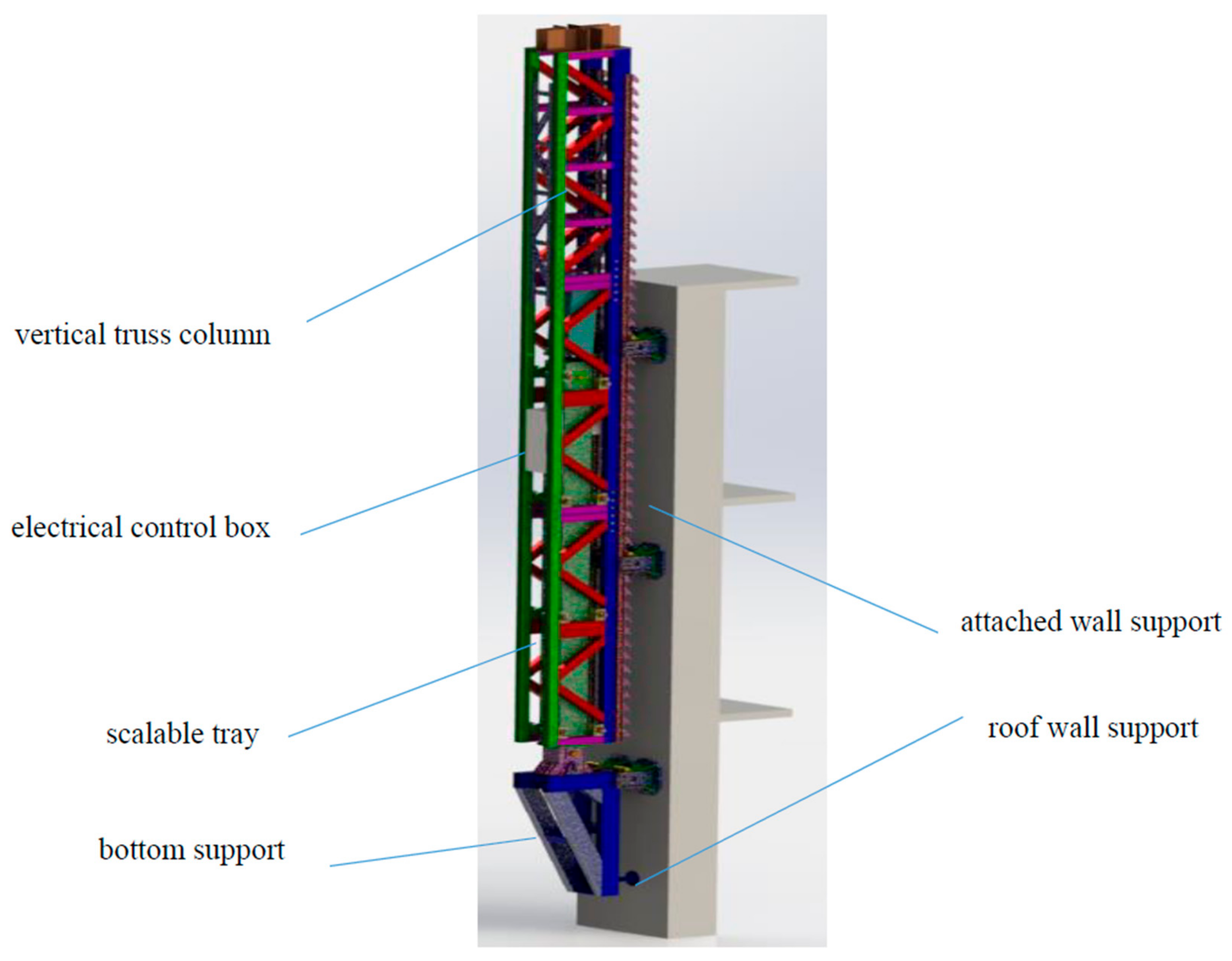
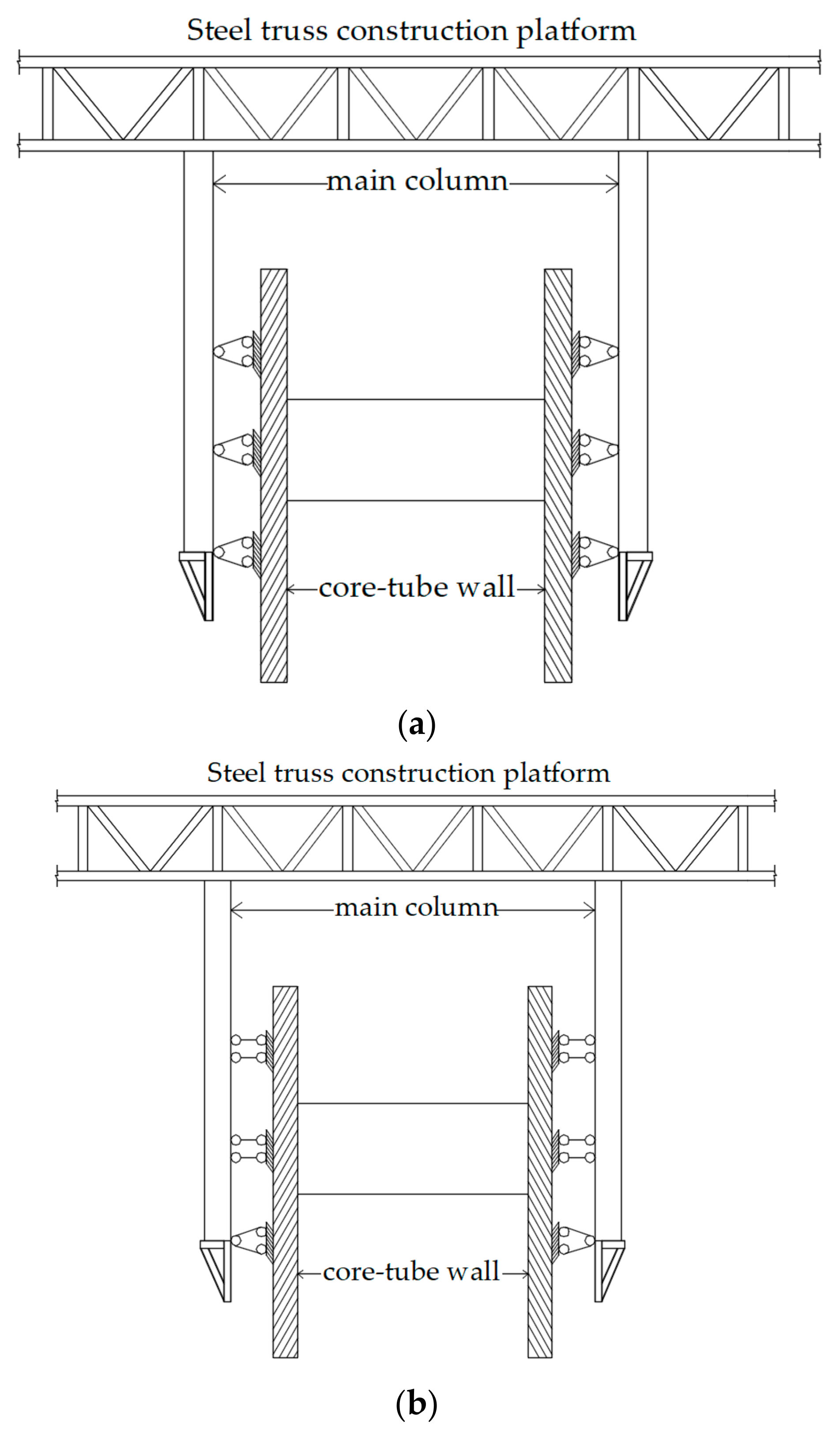

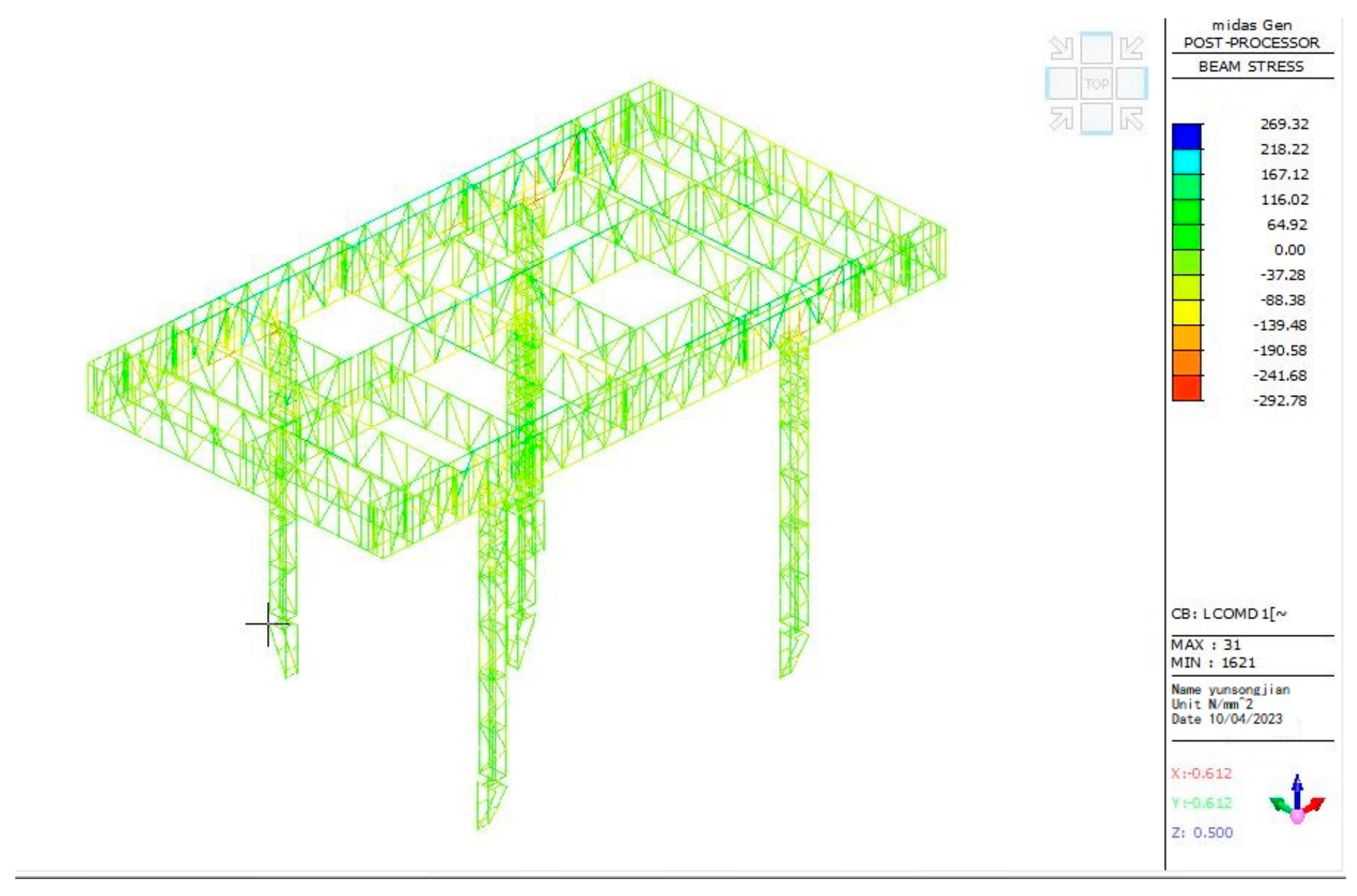
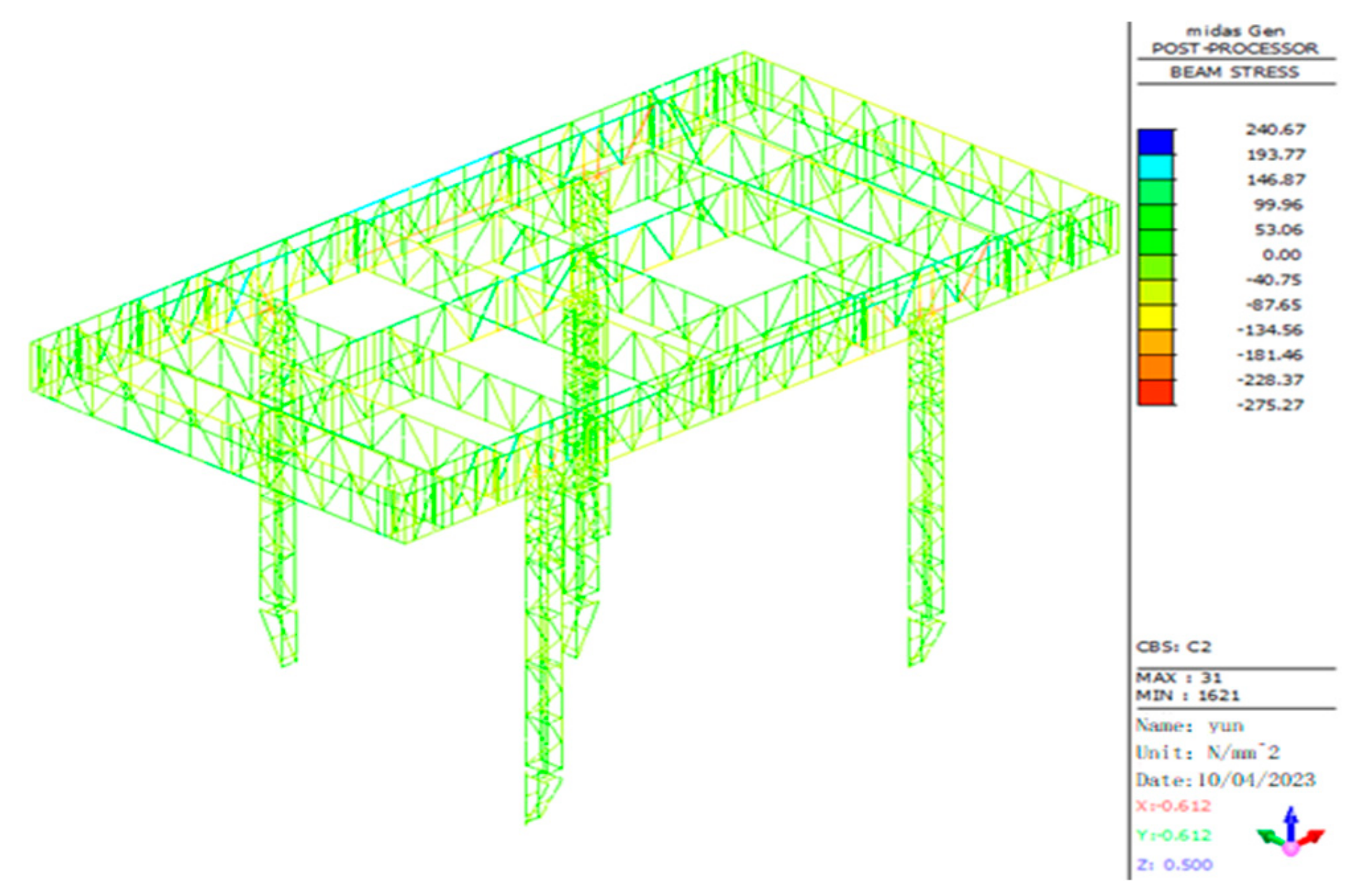


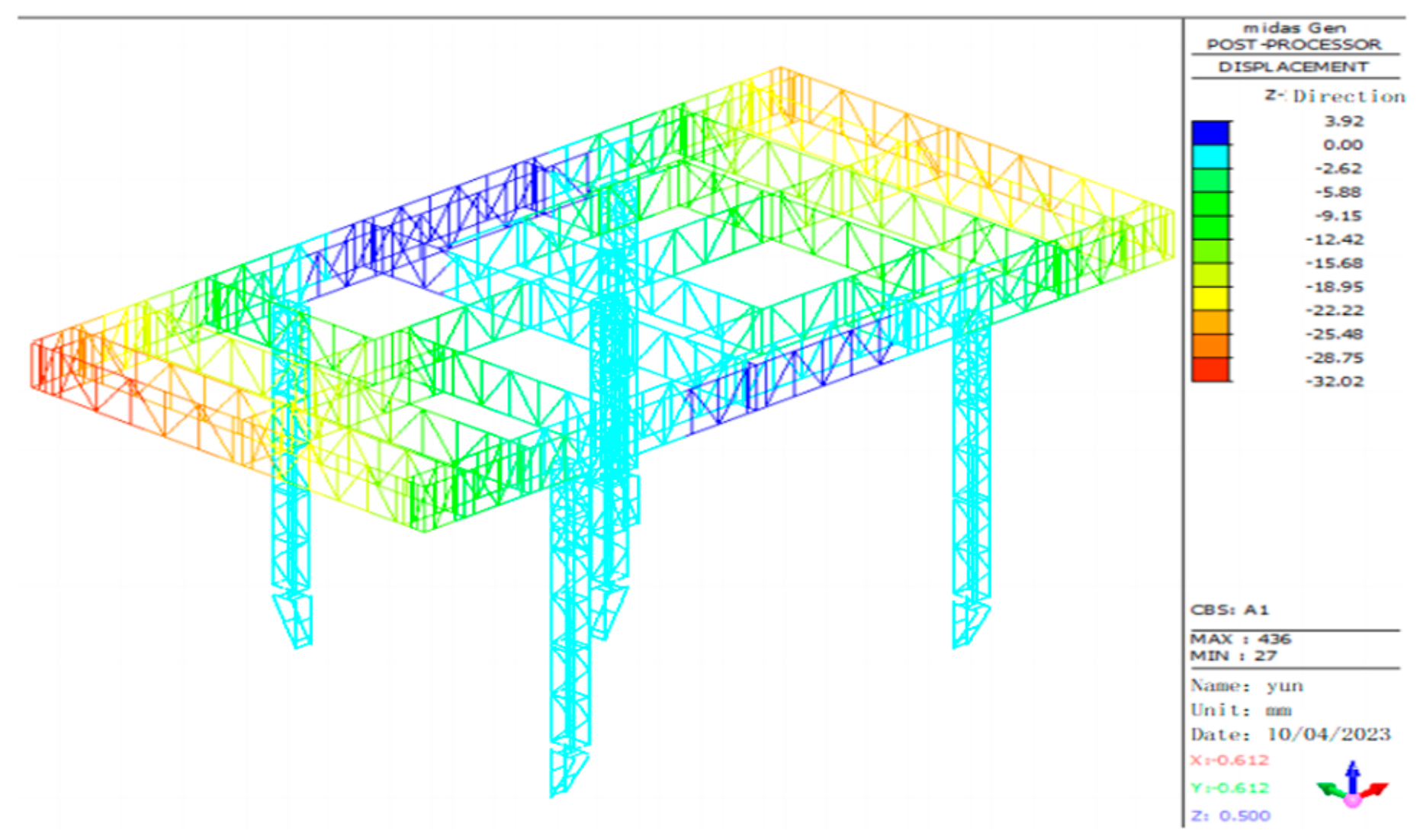
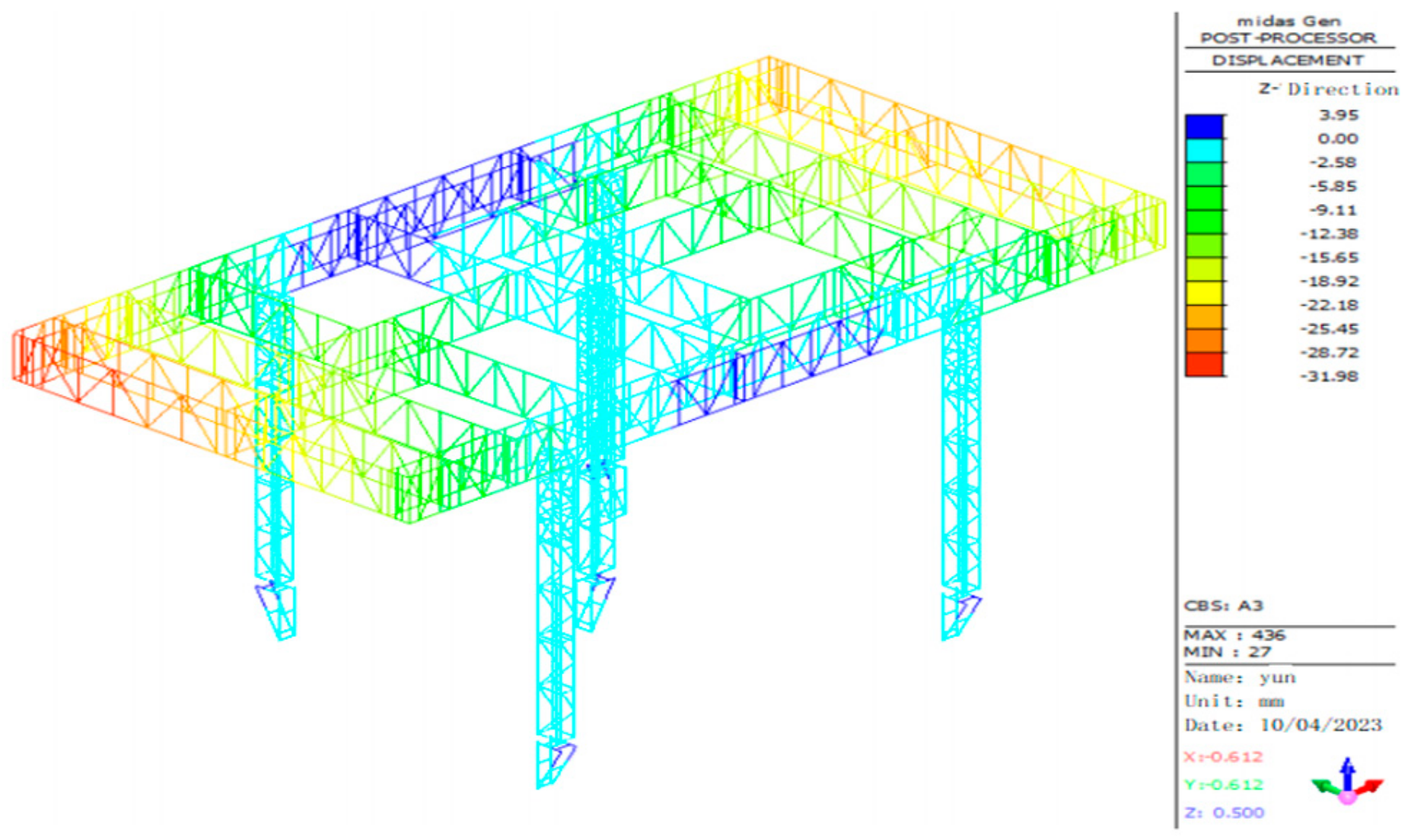


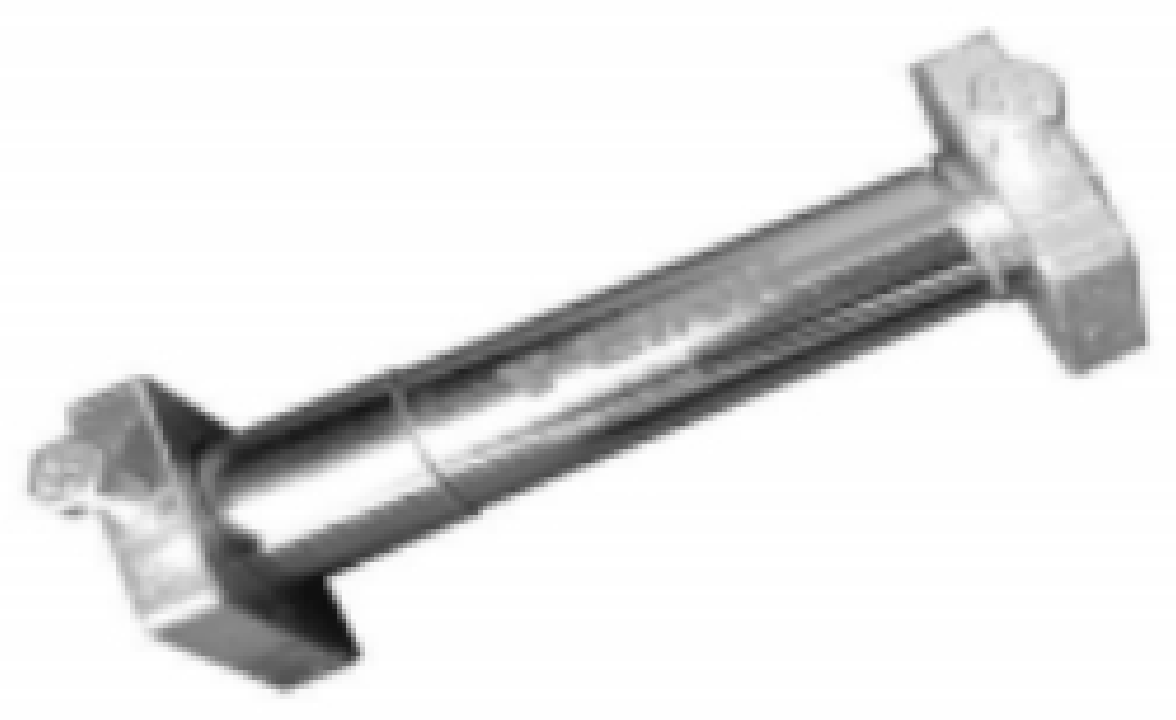
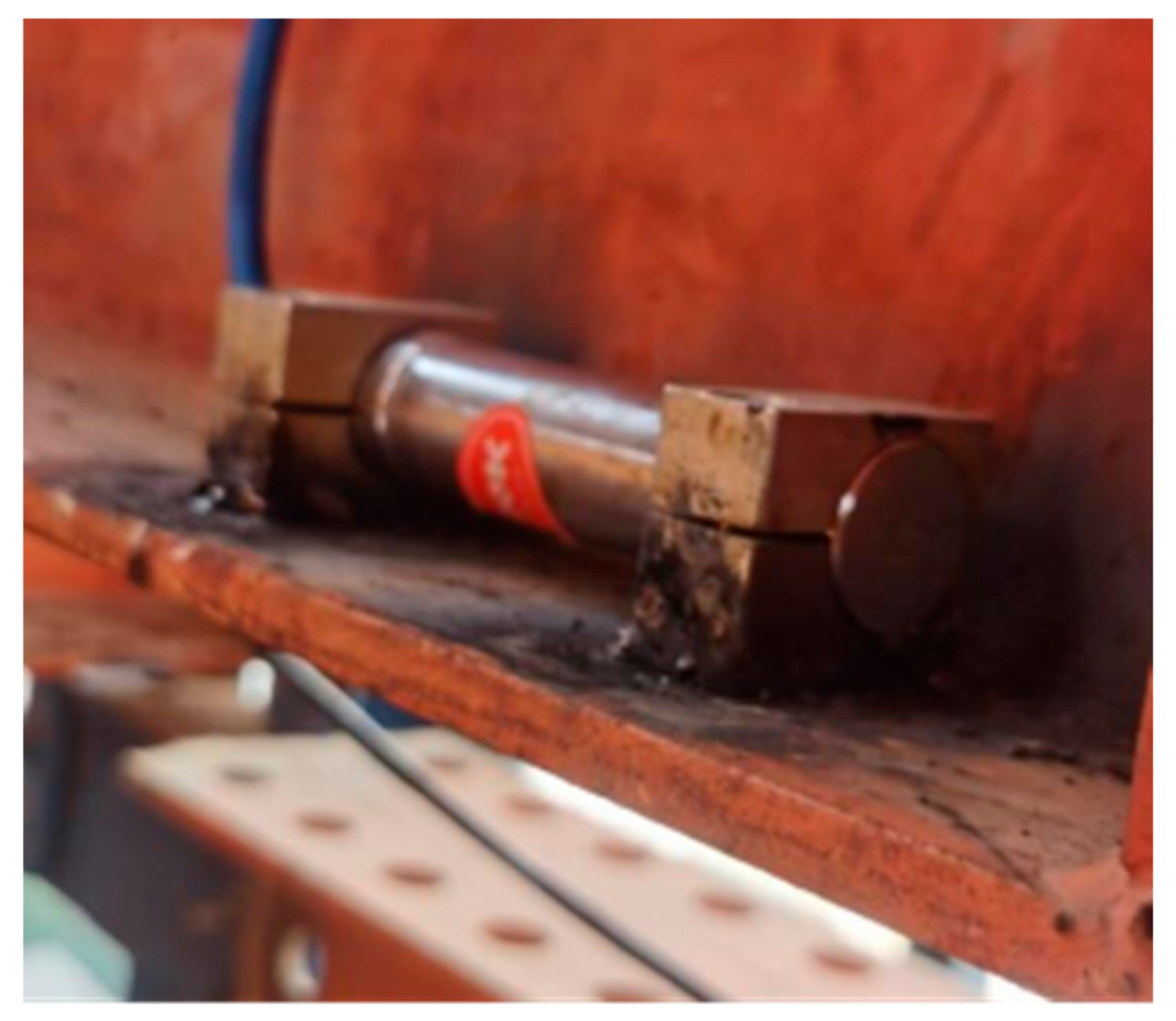






| Member | Name | Sectional Dimension |
|---|---|---|
| Truss | Upper and lower chord | HW300 mm × 300 mm × 10 mm × 15 mm |
| Oblique ventral rod | HW150 mm × 150 mm × 7 mm × 10 mm | |
| Vertical web member | HW300 mm × 150 mm × 6.5 mm × 9 mm | |
| Connecting piece | ☐150 mm × 150 mm × 16 mm | |
| Steel column | Inner tube | ☐400 mm × 400 mm × 20 mm |
| Outer tube | ☐470 mm × 470 mm × 16 mm | |
| Outrigger truss | Chord member | ☐300 mm × 150 mm × 15 mm |
| Web member | ☐150 mm × 150 mm × 15 mm |
| Load Name | Load Values | |
|---|---|---|
| Construction platform | Construction platform plate | 0.33 kN/m2 |
| Internal protective fence | 0.12 kN/m2 | |
| External protective fence | 0.18 kN/m2 | |
| Fabric machine | 10 t | |
| Construction platform support keel | H-shaped steel | 0.28 kN/m |
| Channel steel | 0.15 kN/m | |
| Gallows | Hanging beam | 0.28 kN/m |
| Outboard suspension | 4.6 kN/m | |
| Inside hanger | 3.0 kN/m | |
| Aluminum alloy formwork | 1.2 kN/m | |
| Load Name | Load Values |
|---|---|
| Walkway of crane beam | 1.55 kN/m2 |
| Steel truss construction platform | 0.5 kN/m2 |
| Loading of steel bar | 6.0 kN/m2 |
| Modality | Eigenvalue |
|---|---|
| 1 | 5.105 |
| 2 | 8.099 |
| 3 | 10.151 |
| 4 | 10.456 |
| 5 | 11.096 |
| 6 | 11.819 |
| Rod Parts | Rising Stage | Construction Stage | Lifting Cord Stage | |||
|---|---|---|---|---|---|---|
| Measured Range | Value of Simulation | Measured Range | Value of Simulation | Measured Range | Value of Simulation | |
| ZHJ-1-1 | 0.55~65.83 | 59.62 | 77.81~123.06 | 118.67 | 0.18~48.28 | 50.61 |
| ZHJ-1-2 | −45.05~−24.33 | −43.11 | −116.02~−96.32 | −114.9 | −44.50~−1.29 | −42.65 |
| ZHJ-1-3 | −70.31~−59.11 | −69.17 | −165.04~−108.12 | −155.89 | −59.66~−30.97 | −56.82 |
| CHJ-1 | 86.48~88.74 | 92.56 | 137.06~139.66 | 145.26 | 102.79~107.48 | 102.84 |
Disclaimer/Publisher’s Note: The statements, opinions and data contained in all publications are solely those of the individual author(s) and contributor(s) and not of MDPI and/or the editor(s). MDPI and/or the editor(s) disclaim responsibility for any injury to people or property resulting from any ideas, methods, instructions or products referred to in the content. |
© 2024 by the authors. Licensee MDPI, Basel, Switzerland. This article is an open access article distributed under the terms and conditions of the Creative Commons Attribution (CC BY) license (https://creativecommons.org/licenses/by/4.0/).
Share and Cite
Chang, L.; Zeng, F.; Guo, H.; Zhang, Z.; Gao, T. Construction Simulation and Monitoring of the Jacking Steel Truss and Main Column of a Super High-Rise Building. Buildings 2024, 14, 617. https://doi.org/10.3390/buildings14030617
Chang L, Zeng F, Guo H, Zhang Z, Gao T. Construction Simulation and Monitoring of the Jacking Steel Truss and Main Column of a Super High-Rise Building. Buildings. 2024; 14(3):617. https://doi.org/10.3390/buildings14030617
Chicago/Turabian StyleChang, Li, Fankui Zeng, Haiying Guo, Zhenyu Zhang, and Teng Gao. 2024. "Construction Simulation and Monitoring of the Jacking Steel Truss and Main Column of a Super High-Rise Building" Buildings 14, no. 3: 617. https://doi.org/10.3390/buildings14030617
APA StyleChang, L., Zeng, F., Guo, H., Zhang, Z., & Gao, T. (2024). Construction Simulation and Monitoring of the Jacking Steel Truss and Main Column of a Super High-Rise Building. Buildings, 14(3), 617. https://doi.org/10.3390/buildings14030617





